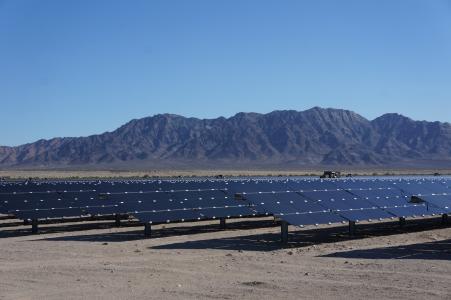By Maria Gallucci -

Giant solar power plants are playing a greater role in California’s electricity mix, new data show. Large-scale systems made up 5 percent of the state’s power generation last year -- the highest amount any state has ever seen.
Solar plants with at least 1 megawatt in power capacity together generated a record 9.9 million megawatt-hours of electricity last year in California, a 62 percent jump over 2013 levels, according to the latest Electric Power Monthly report from the U.S. Energy Information Administration (EIA). California’s utility-scale solar production was more than triple the output of the next-highest state, Arizona, and more than all other states combined.

The surge in California’s solar output was driven by a handful of massive new plants, including the Topaz Solar Farm in San Luis Obispo County and Desert Sunlight Solar Farm in the Mojave Desert. Each has a capacity of 550 megawatts, making them among the largest solar plants of their kind in the world. With those plants and others, California added nearly 1,900 megawatts of new utility-scale solar capacity in 2014, raising the state’s overall solar sector to nearly 10,000 megawatts -- or enough to power some 2.4 million homes.
California now accounts for about half of the country’s solar power capacity. The U.S. solar sector jumped to nearly 20,000 megawatts in combined capacity last year after a banner year for installations. Plunging equipment costs, more efficient technology and better financing plans are making it easier and cheaper for Americans to go solar. As a result, the U.S. market for solar photovoltaics (PV) hit $13.4 billion last year, up from just $3 billion in 2009, according to GTM Research in Boston.
The EIA report also cited generous state renewable policies for driving the growth in sun-powered energy. In a handful of states, residents can receive rebates to help offset the cost of rooftop panels and join “net-metering” programs, which allow homeowners and businesses to sell solar power back to the utility grid. In California, the state requires utilities to get at least 33 percent of the power they sell from renewables by 2020, a policy that has pushed many electricity companies to invest in the large-scale solar farms.
California’s solar boom comes at a particularly critical time for the Golden State. The ongoing drought crisis is depleting the state’s reservoirs, and as a result, hydroelectric generation dropped 46 percent last year compared with the previous five-year average, the EIA said. “Although solar is only available at certain times of the day, the annual increase in California’s solar generation in 2014 offset 83 percent of the decrease in hydroelectric generation,” according to the report.
